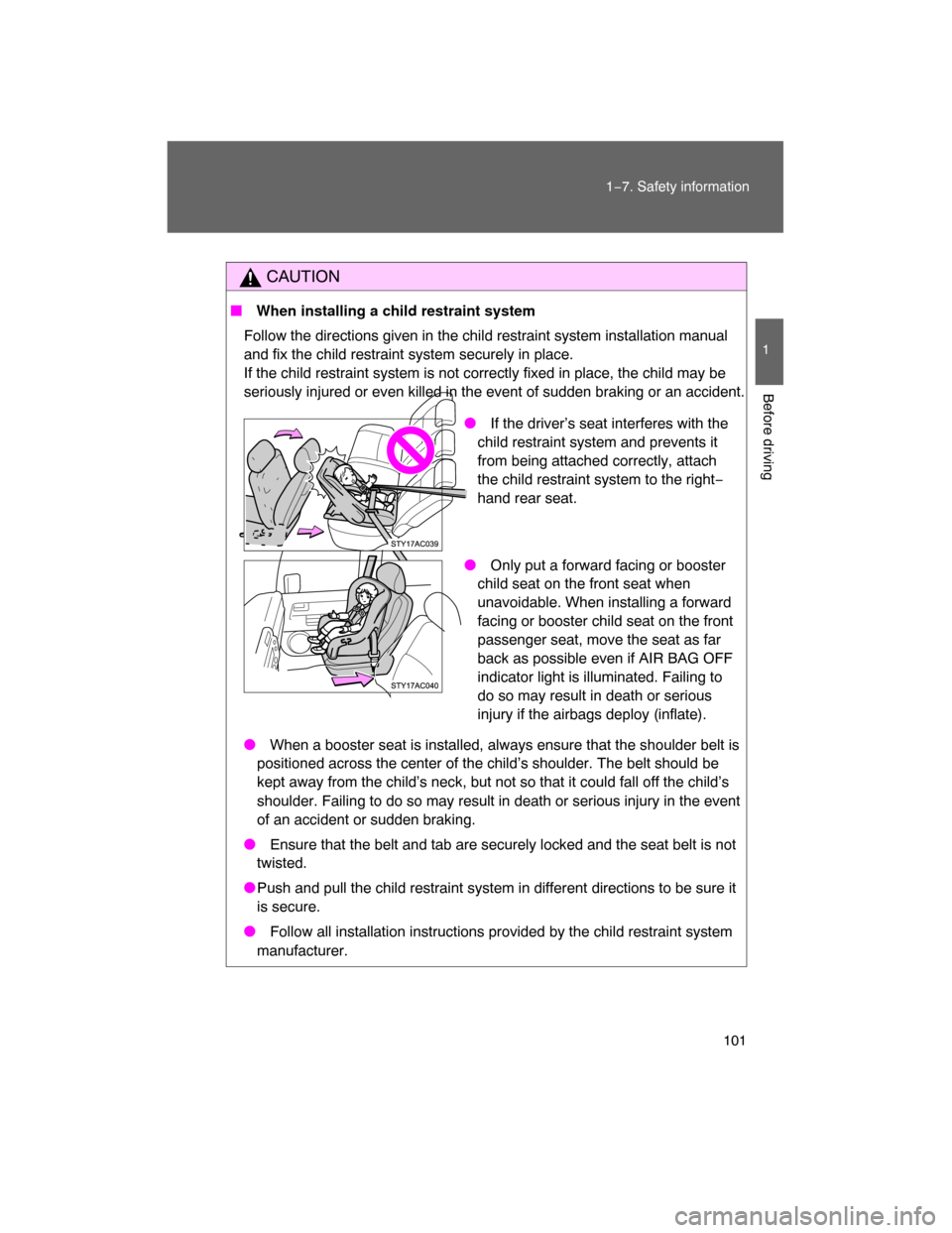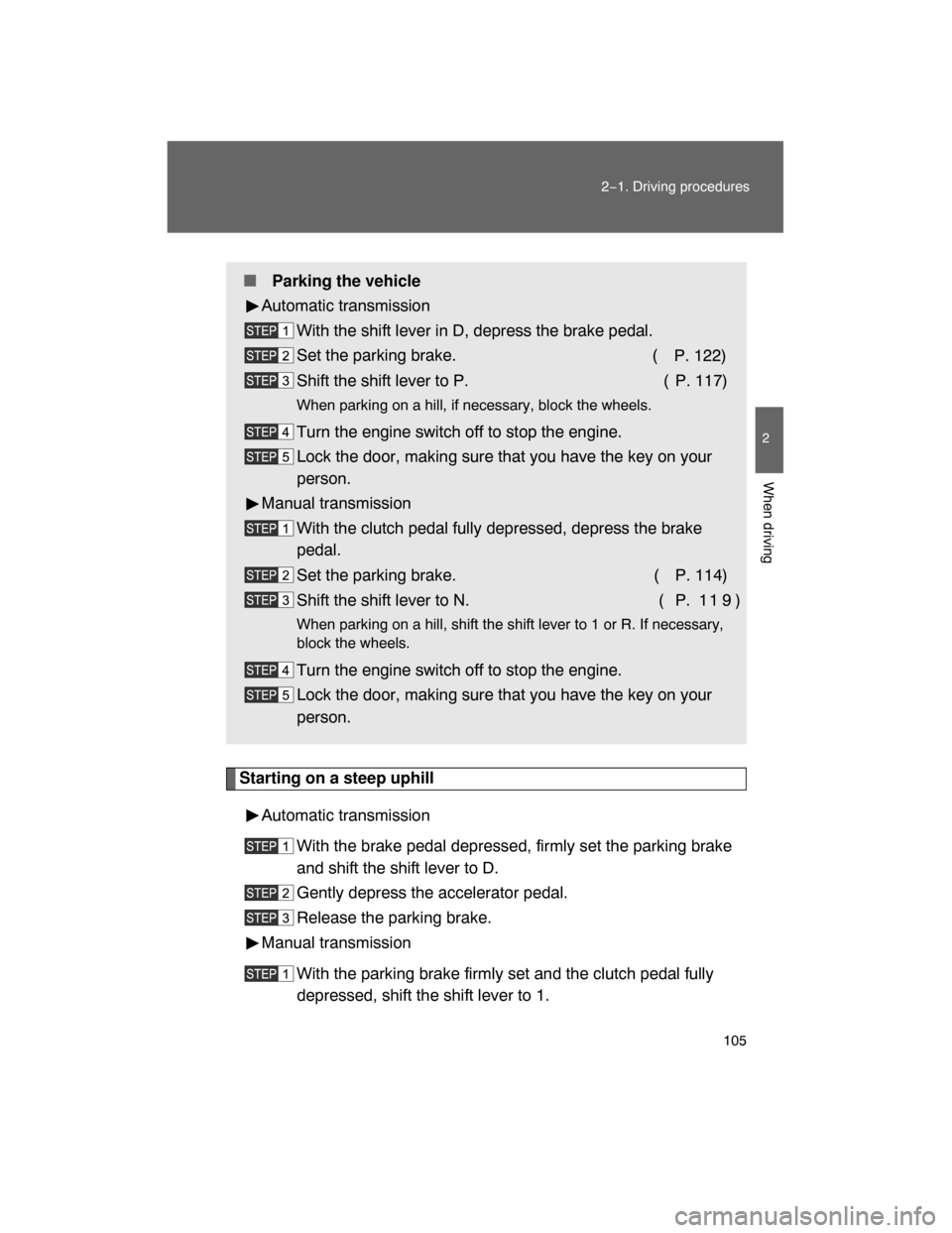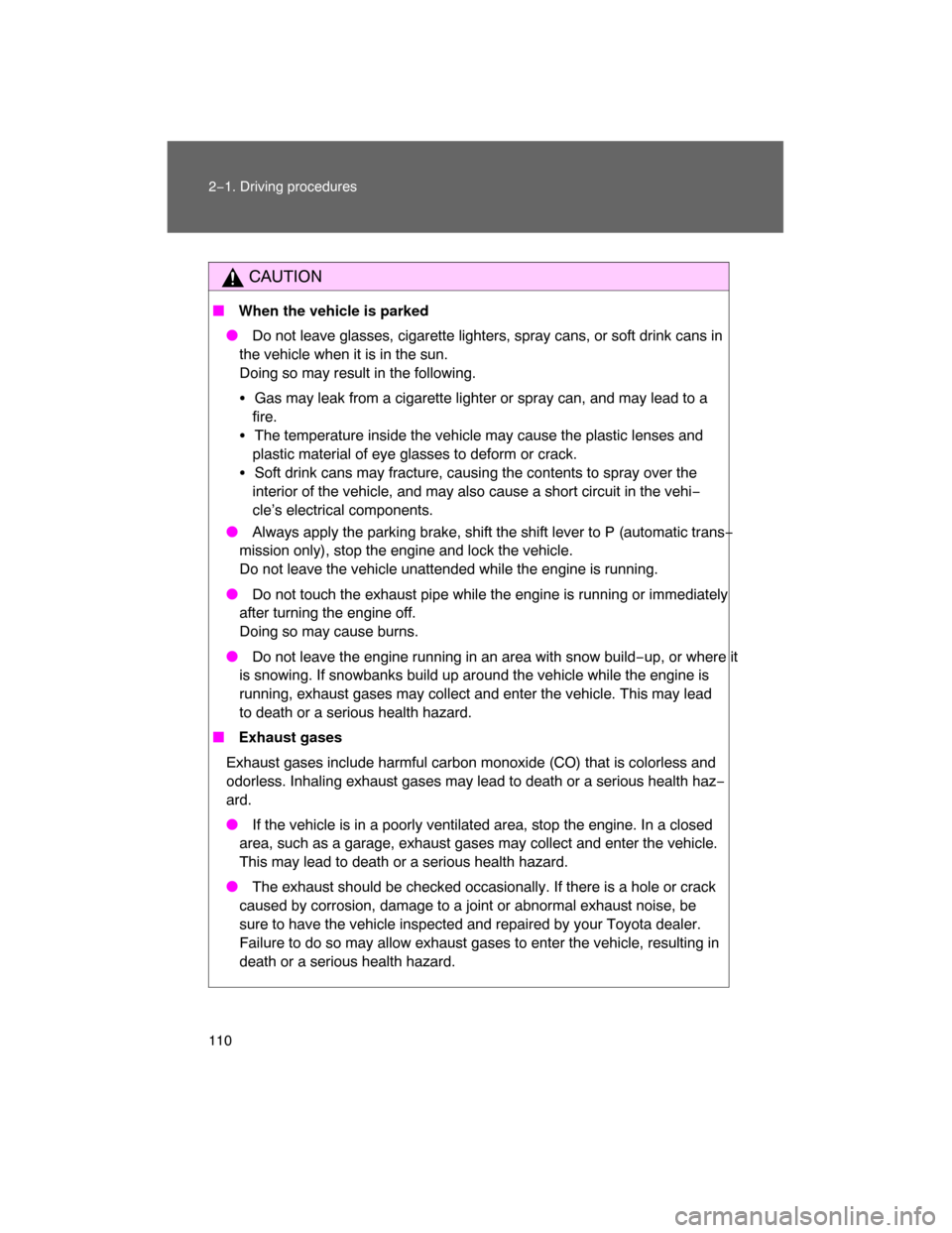Page 99 of 400
100 1−7. Safety information
� When the anchor bracket is not in use
CAUTION
� When installing a booster seat
Do not fully extend the shoulder belt to prevent the belt from going to ALR
lock mode. ( P. 53)
�ALR mode causes the belt to tighten only which could cause injury or dis−
comfort to the child.
� Do not allow the child to play with the seat belt or the child could be killed
or seriously injured.
Lower the anchor bracket.
The anchor bracket is only designed to
secure the top strap. Do not use the
anchor bracket for any other purpose.
Page 100 of 400

101
1−7. Safety information
1
Before driving
CAUTION
� When installing a child restraint system
Follow the directions given in the child restraint system installation manual
and fix the child restraint system securely in place.
If the child restraint system is not correctly fixed in place, the child may be
seriously injured or even killed in the event of sudden braking or an accident.
� When a booster seat is installed, always ensure that the shoulder belt is
positioned across the center of the child’s shoulder. The belt should be
kept away from the child’s neck, but not so that it could fall off the child’s
shoulder. Failing to do so may result in death or serious injury in the event
of an accident or sudden braking.
� Ensure that the belt and tab are securely locked and the seat belt is not
twisted.
�Push and pull the child restraint system in different directions to be sure it
is secure.
� Follow all installation instructions provided by the child restraint system
manufacturer.
� If the driver’s seat interferes with the
child restraint system and prevents it
from being attached correctly, attach
the child restraint system to the right−
hand rear seat.
� Only put a forward facing or booster
child seat on the front seat when
unavoidable. When installing a forward
facing or booster child seat on the front
passenger seat, move the seat as far
back as possible even if AIR BAG OFF
indicator light is illuminated. Failing to
do so may result in death or serious
injury if the airbags deploy (inflate).
Page 103 of 400

105
2−1. Driving procedures
2
When driving
Starting on a steep uphill
Automatic transmission
With the brake pedal depressed, firmly set the parking brake
and shift the shift lever to D.
Gently depress the accelerator pedal.
Release the parking brake.
Manual transmission
With the parking brake firmly set and the clutch pedal fully
depressed, shift the shift lever to 1. � Parking the vehicle
Automatic transmission
With the shift lever in D, depress the brake pedal.
Set the parking brake. (
P. 122)
Shift the shift lever to P. ( P. 117)
When parking on a hill, if necessary, block the wheels.
Turn the engine switch off to stop the engine.
Lock the door, making sure that you have the key on your
person.
Manual transmission
With the clutch pedal fully depressed, depress the brake
pedal.
Set the parking brake. ( P. 114)
Shift the shift lever to N. ( P. 1 1 9 )
When parking on a hill, shift the shift lever to 1 or R. If necessary,
block the wheels.
Turn the engine switch off to stop the engine.
Lock the door, making sure that you have the key on your
person.
Page 108 of 400

110 2−1. Driving procedures
CAUTION
� When the vehicle is parked
� Do not leave glasses, cigarette lighters, spray cans, or soft drink cans in
the vehicle when it is in the sun.
Doing so may result in the following.
�Gas may leak from a cigarette lighter or spray can, and may lead to a
fire.
�The temperature inside the vehicle may cause the plastic lenses and
plastic material of eye glasses to deform or crack.
�Soft drink cans may fracture, causing the contents to spray over the
interior of the vehicle, and may also cause a short circuit in the vehi−
cle’s electrical components.
� Always apply the parking brake, shift the shift lever to P (automatic trans−
mission only), stop the engine and lock the vehicle.
Do not leave the vehicle unattended while the engine is running.
� Do not touch the exhaust pipe while the engine is running or immediately
after turning the engine off.
Doing so may cause burns.
� Do not leave the engine running in an area with snow build−up, or where it
is snowing. If snowbanks build up around the vehicle while the engine is
running, exhaust gases may collect and enter the vehicle. This may lead
to death or a serious health hazard.
� Exhaust gases
Exhaust gases include harmful carbon monoxide (CO) that is colorless and
odorless. Inhaling exhaust gases may lead to death or a serious health haz−
ard.
� If the vehicle is in a poorly ventilated area, stop the engine. In a closed
area, such as a garage, exhaust gases may collect and enter the vehicle.
This may lead to death or a serious health hazard.
� The exhaust should be checked occasionally. If there is a hole or crack
caused by corrosion, damage to a joint or abnormal exhaust noise, be
sure to have the vehicle inspected and repaired by your Toyota dealer.
Failure to do so may allow exhaust gases to enter the vehicle, resulting in
death or a serious health hazard.
Page 112 of 400
114
2−1. Driving procedures
Engine (ignition) switch
� Engine switch
LOCK
The steering wheel is locked
and the key can be removed.
ACC
Some electrical components
such as the audio system can
be used.
ON
All electrical components can
be used.
START
For starting the engine.
� Starting the engine
Automatic transmission
Check that the parking brake is set.
Check that the shift lever is set in P.
Sit in the driver ’s seat and firmly depress the brake pedal.
Turn the engine switch to the START position and start the
engine.
Manual transmission
Check that the parking brake is set.
Check that the shift lever is set in N.
Firmly depress the brake pedal and clutch pedal.
Turn the engine switch to the START position and start the
engine.
Page 113 of 400
115
2−1. Driving procedures
2
When driving
� Turning the key from ACC to LOCK
� Steering lock release
� If the engine does not start
The engine immobilizer system may not have been deactivated. ( P. 68)
� Key reminder function
A buzzer sounds if the driver ’s door is opened, while the engine switch is in
the ACC or LOCK position to remind you to remove the key.
CAUTION
� When starting the engine
Always start the engine while sitting in the driver’s seat. Do not depress the
accelerator while starting the engine under any circumstances.
Doing so may cause an accident resulting in death or serious injury.
Shift the shift lever to P (auto−
matic transmission) or N (man−
ual transmission). (
P. 1 1 7119)
Push in the key and turn to the
LOCK position.
When starting the engine, the engine
switch may seem stuck in the LOCK posi−
tion. To free it, turn the key while turning
the steering wheel slightly in either direc−
tion.
Page 114 of 400
116 2−1. Driving procedures
CAUTION
� Caution while driving
Do not turn the engine switch to the LOCK position.
If in an emergency, you must turn the engine off while the vehicle is moving,
turn the engine switch only to the ACC position.
NOTICE
� To prevent battery discharge
Do not leave the engine switch in the ACC or ON position for long periods if
the engine is not running.
� When starting the engine
� Do not crank for more than 30 seconds at a time. This may overheat the
starter and wiring systems.
�Do not race a cold engine.
�
If the engine becomes difficult to start or stalls frequently, have the engine
checked immediately.
Page 126 of 400
128 2−2. Instrument cluster
� Indicators
The indicators inform the driver of the operating state of the
vehicle’s various systems.
Turn signal indicator
(
P. 121)(if equipped)
Active traction control
system indicator (
P.
148)
Headlight high beam
indicator (
P. 131)
*
(if equipped)
AUTO LSD indicator
(
P. 150)
Security indicator
(
P. 68)(if equipped)
Four−wheel drive
indicator(
P. 146)
(Automatic
transmission
vehicles)
Shift position and shift
range indicators
(
P. 117)
(if equipped)
Center differential lock
indicator (
P. 144)
(if equipped)
Rear differential lock
indicator (
P. 152)
(if equipped)
Cruise control indicator
(
P. 136)
*AIR BAG ON indicator
(
P. 85)
*Slip indicator
(
P. 148, 150, 156)
*AIR BAG OFF indicator
(
P. 85)
*VSC OFF indicator
(
P. 157)